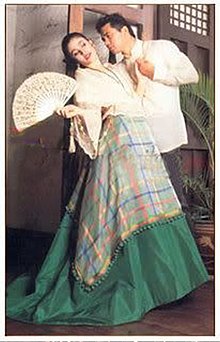Cariñosa
This article needs additional citations for verification. (December 2021) |
 A performance of Cariñosa | |
| Origin | Philippines |
|---|---|
The cariñosa (Spanish pronunciation: fan or handkerchief plays an instrumental role as it places the couple in a romance scenario.
History
The cariñosa originated in
jarabe tapatio
or the Mexican hat dance.
Bicolano cariñosa
According to the book of
festivals
and social gatherings.
Costume
Originally, the cariñosa was danced with
Barong Tagalog for it is a Spanish dance. In addition, Filipino wore the patadyong kimona and camisa de chino to reveal nationalism. (a native dress of the Tagalog
regions), camisa (a white sleeve) or patadyong kimona (a dress of the Visayan people) and for boys, a barong Tagalog and colored pants.
Status as a Philippine national dance
The cariñosa is considered to be an official national dance of the Philippines, as no law has designated them as such.[2] In 2014, House Representative Rene Relampagos introduced a bill in the House of Representatives to grant the cariñosa such a status,[3] which did not become law.
References
- ^ "Google Pays Tribute to Francisca Reyes Aquino on Her 120th Birth Anniversary". ANCX. March 9, 2019. Retrieved December 2, 2021.
- ^ Alba, Reinerio A. (August 28, 2009). "In Focus: Official National Symbols of the Philippines". National Commission for Culture and the Arts. Retrieved December 2, 2021.
- Philippine House of Representatives. Archived from the original(PDF) on November 18, 2017. Retrieved December 2, 2021.

